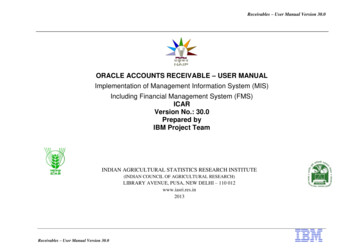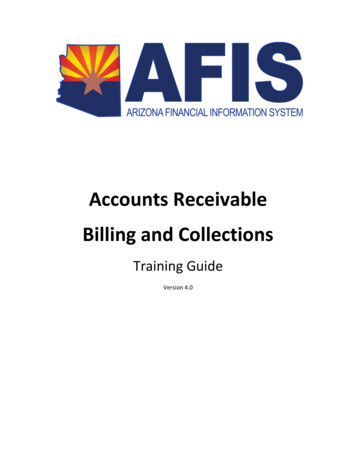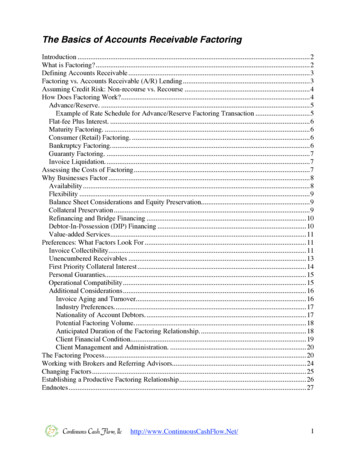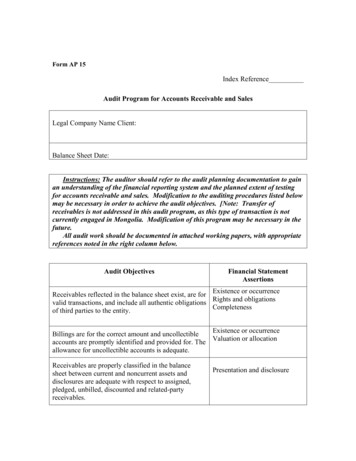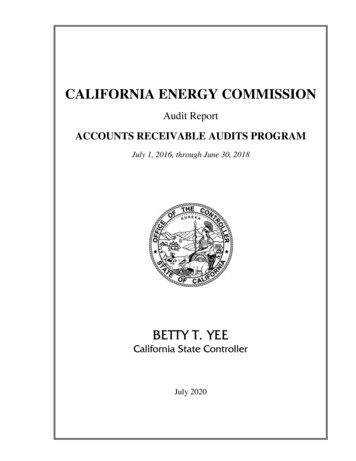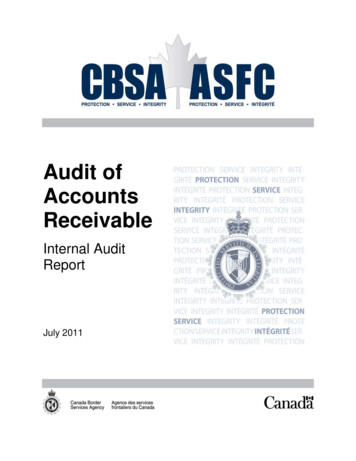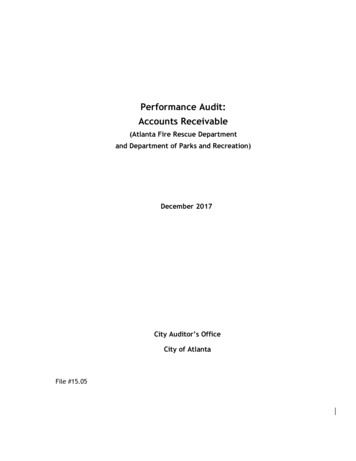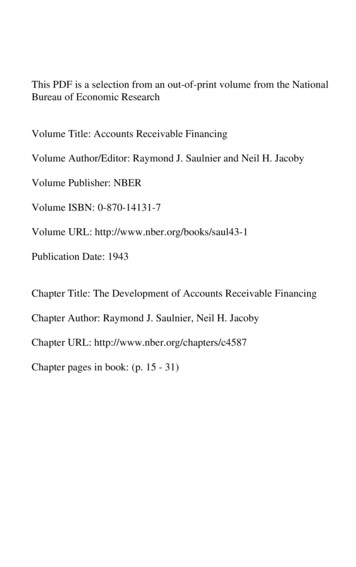
Transcription
This PDF is a selection from an out-of-print volume from the NationalBureau of Economic ResearchVolume Title: Accounts Receivable FinancingVolume Author/Editor: Raymond J. Saulnier and Neil H. JacobyVolume Publisher: NBERVolume ISBN: 0-870-14131-7Volume URL: http://www.nber.org/books/saul43-1Publication Date: 1943Chapter Title: The Development of Accounts Receivable FinancingChapter Author: Raymond J. Saulnier, Neil H. JacobyChapter URL: http://www.nber.org/chapters/c4587Chapter pages in book: (p. 15 - 31)
The Development of Accounts ReceivableFinancingWHEN THE FEDERAL RESERVE SYSTEM was organized it wasthought by many that two-name commercial paper would pro-vide the chief medium through which the resources of theReserve Banks would be made available to the banking community. As a result, considerable interest was focused on thetrade acceptance; Federal Reserve authorities and other agencies encouraged its wider use in commercial transactions. It iswell known that these efforts were for the most part unavail-ing; for a variety of reasons the trade acceptance did notcome into as wide a usage as had been hoped for. Broadlyspeaking, the method of financing that was involved did notconform to the practices of American business.'While this attempt to promote the use of the trade acceptance was meeting with disappointing results, a related technique of business financing based on the open account sale ofmerchandise was developing in the American short-term creditmarket. This occurred not only without organized support orofficial sponsorship but even in spite of considerable resistance.The technique of open accounts receivable financing is impor-tant from a number of points of view, not the least of whichis that it was apparently so well adapted to the financing needsof certain types of business concerns that it gained wide application while the trade acceptance of conventional form failedto develop even with the most patient cultivation.Accounts receivable financing is not a new development.The open account has long been recognized as one of thepreferred assets of business concerns; a good deal of theattention of the banker has always been centered on theamount and quality of these accounts and on their relation
16Accounts Receivable Financingto other quantities in the corporate balance sheet. Beyondthis, the account receivable has been, for centuries, the specific basis of short-term financing in the textile trades by individuals and concerns known as "factors."Of late there has developed a wider and keener interestin accounts receivable financing and in its position in theshort-term credit market. This new interest can be explainedby several related points. First, there is a present, tendency forthe technique to be applied to an ever-widening range of industries. This has given rise to new problems of credit appraisaland, to some extent, to new competitive situations in shortterm financing. Second, non-bank institutions, other than thefactoring companies that have long been active in receivablesfinancing, have developed during relatively recent years andhave come to occupy a prominent position in the short-termbusiness credit field. Third, the business has recently beentaken up by commercial banks, a development that can betraced primarily to the pressure that banks have felt for newavenues of credit extension and to the example of rapidlygrowing commercial finance companies. Fourth, although themovement has been retarded somewhat by the war program,an increasing number of business concerns are now dependingon the sale or assignment of their receivables for the acquisition of working capital. Some of these do so because theirfinancial position precludes borrowing on any other basis,others because they prefer receivables financing over othertypes of financing. Because many of the concerns financedthrough the sale or assignment of their receivables are relatively small and of limited financial strength the technique hasreceived added attention in recent years in connection withquestions relating to the availability of credit for small business enterprises.While this study deals almost exclusively with accountsreceivable financing, an attempt has been made to show howit is related to other financing methods. The study deals withthe development and present quantitative importance of openaccounts receivable financing; the nature of institutions extend-
Development17ing credit on this basis; the main features of the servicesoffered by them; the chief characteristics of the businessesobtaining financial support from these agencies; the methodsfollowed in conducting such financing; and the charges levied,income earned, costs of operation, and profitability of thebusiness.Definition of Accounts Receivable FinancingAccounts receivable financing is a continuing arrangementwhereby funds are made available to a business concern bya financing agency that purchases the concern's invoices oraccounts receivable over a period of time or makes that concern advances or loans, taking one or a series of assignmentsof the accounts as primary collateral security.' There are twoprincipal types of receivables financing. One type is known asfactoring. This consists of purchasing invoices or receivables,where trade debtors are notified that payments are to be madeto the financing agency and where this agency generallyassumes the credit risks on the receivables. The other majortype will be referred to as non-notification financing. Thisinvolves the purchase or assignment of invoices or receivableswithout notice to the trade debtor that the account has beensold or assigned and without the assumption by the financingagency of credit risks on purchased or assigned accounts.Two limitations on the scope of the study should be noted.First, primary emphasis is laid on the financing of openaccounts receivable as distinguished from the financing ofinstalment notes receivable. The discounting of instalmentreceivables has been discussed in detail in previous studies ofthe National Bureau of Economic Research.2 Second, this1In factoring and in non-notification financing as conducted by commercialfinance companies the financing agency buys invoices rather than accountsreceivable, which may be cumulations of several unpaid invoices. Although"invoice financing" is a more strictly accurate term for this type of arrangement the expression "accounts receivable financing" is widely used in thetrade and will be used here.2See National Bureau of Economic Research (Financial Research Program),Sales Finance Companies and Their Credit Practices, by Wilbur C. Plurnmerand Ralph A. Young (1940); and Commercial Banks and Consumer InstalmentCredit, by John M. Chapman and Associates (1940).
18Accounts Receivable Financingstudy does not treat, except incidentally, of the use of theaccounts receiva ble financing technique by commercial banksas a method of "working ou't" unsatisfacto ry credit relationships arising f rom previous loans made on another basis.It is concerned with open accounts receivabi e financing enteredinto on its own merits, where the primary dependence of thefinancing agency is, from the outset, on the purchased orassigned account receivable.Business Demand for Factoring ServicesAccounts receivable financing, as a technique for supplying funds to business enterprises, evolved many years agoout of business demands that went far beyond the need foradvances of funds. As early as the fourteenth century, manufacturers and merchants in both foreign and domestic tradefelt the need for some specialized agency to perform a sell-ing and merchandising service for them (not unlike thatoffered by the commission merchant in more recent times).Since sales were generally made on credit terms of 30 daysor longer, it proved to be convenient for the agency responsible for making sales also to advise on the wisdom of extending trade credit to any given buyer. Finally, this agent (the"factor") undertook in some instances to absorb losses arisingout of credit sales by buying the open accounts so originatedwithout recourse on the seller (the factor's "client"). Ineffect, the seller or manufacturer was placed in the positionof making all sales for cash.The demand for this combination of services prompted theemergence of factoring as an economic function. The natureof the services performed by the factor clearly indicates thatsuch services would be particularly useful to concerns sellingin foreign markets in which the creditworthiness of buyerswas unlikely to be known to the sellers. For this reason thefactor came to occupy an important place in American colonialtrade, operating as buyer, sales agent, carrier of credit risks,collector of accounts, and general commercial representativeon this continent for English companies. The selling and styl-
Developmenting functions of the factor proved to be particularly importantin the textile trade where market demand was much affectedby fashion changes. Thus, in the nineteenth century the factor was prominently associated with sales in the United Statesby foreign textile mills and later assumed a major role infinancing domestic mills and in marketing their product.Because of the importance of the import market in textiles,and particularly because of their role as selling agents, factorsearly established themselves in Boston and New York. Withthe greater growth of New York in importing and merchandising, factoring companies gradually centered in that city.The tendency for these companies to locate on Fourth Avenue, in close proximity to one another, has led to their beingreferred to as "Fourth Avenue houses." More recently theyhave been designated as the "old-line" or "straight" factors,in distinction from the newer open accounts financing companies.In recent years there has been a tendency for the sellingand merchandising functions of the factor to be detachedfrom the financing function. It is customary now for the factor's clients either to organize their own sales departmentsor to use the services of a specialized selling agency or "commission house." In some cases the commission house also performs a financial function, but this service is available only tothe manufacturers whose goods it sells.3A number of reasons explain this tendency for the factor'sactivities to be limited to the performance of a financing function. One is the advantag1e of specialization gained by thefactor, another the independence achieved by the mill thatsets up its own sales department. Still another is the fact thatwhile the factor was under no formal obligation to do so,he often had to make loans on goods which he had s'tyled andwhich proved to be less readily salable than had been antici31t should be emphasized that this change in the functional and institutionalpattern of the market has not resulted in an absolutely clear-cut differencebetween the factor and the commission or selling house. There are some firms,for example, J. P. Stevens and Co., Inc., New York City, that undertake bothfunctions. The concentration of commission merchants on Worth Street, NewYork City, accounts for their being designated "Worth Street houses."
Accounts Receivable Financing20pated; frequently these loans were the source of substantiallosses. All of these causes were amplified by the growing complexity of the market, its greater susceptibility to fashion influences and the desire of both factor and manufacturer to obtainas stable an economic position as possible.Through this specialization, the main functions of thefactor have come to be the purchasing of receivables withassumption of the credit risk" and the necessary corollary ofcollecting accounts. The performance of this risk-taking func-tion made it necessary for the factor to develop an expertcredit appraisal technique and an effective collection procedureand to assemble a specialized personnel to carry on this work.Further, the assumption of credit risks made it necessary tonotify the trade debtor of the factor's purchase of the receivable and to instruct that payments be made directly to thefactor. In contrast, the mill utilizing the factoring servicedid not need to maintain an extensive credit department, oftennone at all, nor to concern itself with the collection of accounts.Furthermore, it was relieved of a large part of its bookkeeping.It is important to recognize that receivables financing, asoffered by the factor, is provided jointly with these otherservices. The growth and continuance of the demand for factoring must be understood in terms of a demand for this combination of services. Also, the level of client costs, which ishigher than that characteristic of some other types of financmust be interpreted in the light of the variety of functions performed by the factor.Business Demand for Non-Notification FinancingThe conditions that led to the development of non-notification receivables financing differ in a number of importantrespects from those that account for the growth of factoring.In contrast to the conditions affecting factoring, the demandfor non-notification financing is not necessarily associated witha demand for credit approval, collection or risk-assumption'This function is sometimes referred to incorrectly as "insuring" credits.
Development21services. The business enterprise seeking capital on this basisusually desires to convert its open accounts into cash withoutdisclosing the fact that it obtains funds in this way. Since itscustomers are not notified that their accounts have been soldor assigned it is therefore necessary that the concern beingfinanced make collections on its own receivables and turn thesecollections over to the financing agency. The fact that col-lections are made in this way raises considerably the risksundertaken by the financing agency and explains in large partwhy the receivables are purchased with recourse on the borrower. Under this arrangement the concern s
accounts receivable as distinguished from the financing of instalment notes receivable. The discounting of instalment receivables has been discussed in detail in previous studies of the National Bureau of Economic Research.2 Second, this 1 In factoring and in non-notification financing as conducted by commercial finance companies the financing agency buys invoices rather than accounts .


